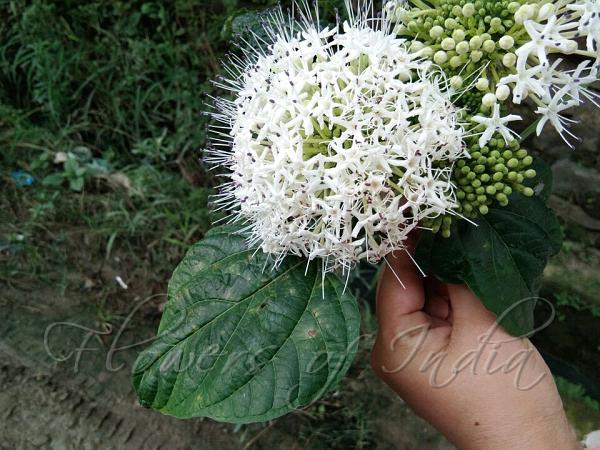|
| East Indian Glory Bower |
|

|

|
|
|
|
Photo: |
Botanical name: Clerodendrum colebrookeanum Family: Verbenaceae (Verbena family)
Synonyms: Clerodendrum ixoriflorum, Clerodendrum glandulosum
Synonyms: Clerodendrum ixoriflorum, Clerodendrum glandulosum
East Indian Glory Bower is a shrub or small tree,
1.5-3 m tall. Branchlets are robust, 4-angled, densely yellow-brown
finely velvet-hairy when young. Leaf stalks are 2-20 cm long, carrying
broadly ovate to elliptic- heart-shaped leaves which are 7-17 cm long,
6-21 cm wide. Leaf base is wedge- shaped to heart-shaped, margin
entire to slightly wavy, tip long-pointed to pointed. Flowers are
borne in 4-6-branched corymbose cymes, at the end of branches. Stalk
carrying the cyme is robust, 1.5-13 cm. Bracts are lanceshaped, 1.5
cm, deciduous. Sepal cup is bell-shaped, 3-5 mm, tube 1-3 mm, densely
velvety, with several peltate glands. Sepals are triangular, less than 1
mm. Flowers are white or rarely pinkish, with a long narrow tube 1.2-2.5
cm. Petals are oblong, 3-6 mm. Stamens and style prominently protrude
out. Fruiting sepal cup is purple, inflated. Fruit is blue-green,
becoming black when dry, nearly round, about 1 cm in diameter. Kuki
people of Manipur cook pork with the leaves of this plant.
East Indian Glory Bower is found in NE India, and parts of China and SE Asia,
at altitudes of 500-2000 m. Flowering: August-December.
| Identification credit: Prashant Awale | Photographed in Imphal, Manipur & Ailong, Mizoram. |
• Is this flower misidentified? If yes,